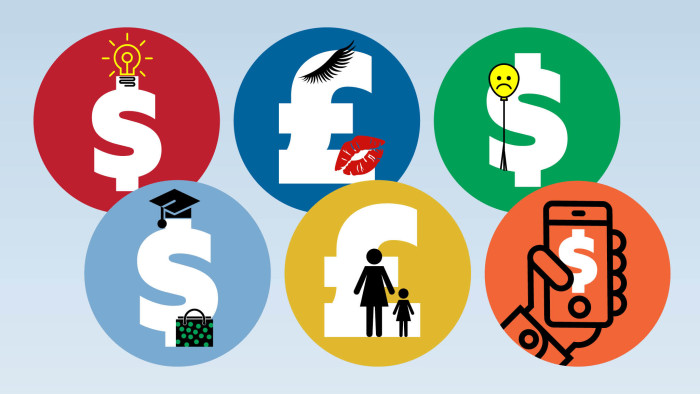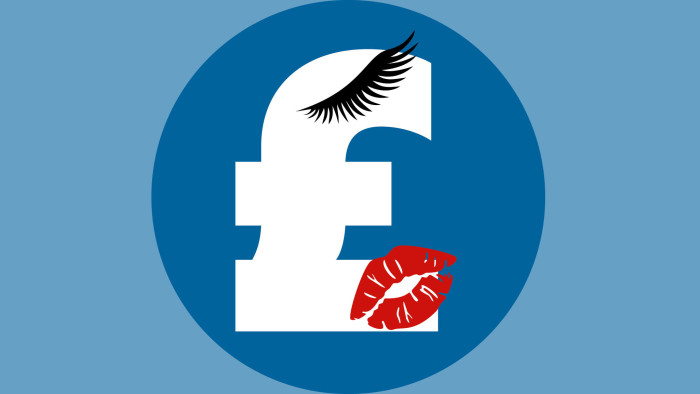The Money Diaries: a financial confessional
Roula Khalaf, Editor of the FT, selects her favourite stories in this weekly newsletter.

“Money is the oil that greases the wheels of society, but oil is filthy sticky stuff and we should clean our hands of it before coming out in polite company.”
The social taboo of discussing one’s finances in public, epitomised by this entry in Debrett’s New Guide to Etiquette and Modern Manners, is becoming a thing of the past. In the confessional #metoo era, modern women are sharing anonymised diary entries detailing their financial foibles — and the internet can’t get enough of them.
There have been many imitations, but the Money Diaries, a series published by US website Refinery29, is the undisputed queen of the genre. Launched in 2016, its weekly publication of an anonymous spending diary soon became a daily event. Promising to bust “the last taboo facing modern working women,” contributions have flooded in from women in the US, UK, Germany, India and Australia who all share one thing — a sense of curiosity about how they are managing their money.
The format is simple: an anonymous contributor provides a brief summary of her regular income and outgoings plus biographical details such as age, job and location, followed by a diary tracking daily spending on everything from clothes to coffees to childcare over the course of a week. The diaries are compelling reading — as are the online comments (the only rule is “start a discussion, not a fire”).
Is the craze to share secrets and slap down spendthrifts just another way of wasting time online — or could this be a new digital frontline for financial education?

Dear diary
From its experimental beginnings in 2016, the Money Diaries has become a powerful source for women hungry for relevant financial information. The viral popularity of the web series has now inspired a book, Money Diaries: Everything You’ve Ever Wanted To Know About Your Finances . . . And Everyone Else’s, published by Touchstone Books in September.
Lindsey Stanberry, who has edited the series from the beginning, admits she was initially sceptical whether the format would work.
“Another editor thought of it . . . I was unsure at first,” she says of the initial post. But when the first Money Diary was published, she realised the format was a winner. “It showed immediately how much money touched all areas of our lives.”
Written by an anonymous 27-year-old Brooklynite, the confessional nature of the series was established from the outset — she muses during a date what a fair price for a line of cocaine would be.
The series is addictive, combining social escapism with financial voyeurism. Reading somebody else’s financial diary offers the vicarious thrill of peering into their life and imagining how you might blow their budget.
But it is the comments section below that provides the true blood sport.
Refinery29 features contributions from women on a wide range of budgets, but the biggest attraction lies in how the entries invite readers to pass judgment.
A poorly paid writer, barely making her rent money, who whacks a £14.50 brunch on her credit card? The commentators below the line predictably explode. It is an acceptable form of moral outrage.
Even though the website’s readership broadly agrees on the importance of recycling, encouraging diversity and eating organic foods, it can quickly descend into incandescent fury over how much someone else chooses to spend on a cappuccino.
Some diaries have generated such a storm of comments and social media posts that they have become the subject of debate in other publications.
Earlier this year, the financial life of a New York intern became one of the series’ legendary entries. Ostensibly interning for $25 an hour, she detailed a lifestyle which included lavish weekend breaks in the Hamptons and grocery runs to Whole Foods, the upmarket organic chain.
“This is the most sickeningly privileged thing I have ever had the misfortune to read,” one commenter wrote of this unwitting lightning rod for millennial privilege. “My blood pressure was a little low today but this fixed it,” added another.
For this reason, The New Yorker described the series as “the most lurid corner of the internet”. Yet these detailed snapshots of 21st century life provide a financial context to a series of modern dilemmas — women struggling with the stigma of outearning their male partners or considering the best time for parenthood.
One poignant diary, written by a 25-year-old in Indiana living with schizophrenia, explores how she will save to pay for a surrogate mother, as her medication is harmful to foetuses.
Extracts from the Money Diaries
The tech engineer

25-year-old, living in California on $122,000 a year, with $46,850 left in student loans
“Rent: $0. I live in my car. My workplace has everything I need, including showers, laundry facilities, and internet.”
The creative industry worker

27-year-old, living in Brooklyn, New York, on a $65,000 salary
“A guy I’m seeing wants to hang out. We do some cocaine. I don’t know how much drugs are supposed to cost, but I heard coke is pricey. I just did a line because it was offered, and I was drunk. The alcohol was free.”
The ambulance driver

Single parent in the UK on £14,000 a year
“I make us sausage rolls, cream mash, sweetcorn and spaghetti. [Daughter] has a yoghurt for pudding and I pretend to her that it’s a normal yoghurt. It doesn’t work and she eats half.”
Read this and weep
One aspect that has been less discussed is whether the diaries can help anyone learn to manage their finances in a practical sense.
Yet keeping a money diary is one of the most repeated pieces of advice when it comes to improving our own personal finances, especially in the era of tap and pay.
“It can be a great exercise, really thinking about those mindless purchases,” says Ms Stanberry, who receives about five fresh submissions a day. “It’s really interesting to see how people make their money work. Some are really good and some are really bad at it.”
While the Money Diaries focus on tracking expenditure, the obvious problem for modern women is disparity of income.
New gender pay gap reporting rules in the UK have caused levels of outrage to boil over within workplaces, where the taboo status of discussing what you earn has helped mask glaring inequalities.
Women earn less than men, pay less into their pensions as a result, and are more likely to take unpaid career breaks — to raise a family, or increasingly, to care for older relatives. Combined with greater female life expectancy, this is storing up huge problems for the future.
In later life, the disparity is set to increase. Women in the UK face a “gender pensions gap” of nearly 40 per cent, according to a recent analysis by Prospect, the trade union.
Numerous research studies have shown that women are less likely to invest than men, and tend to hoard cash, meaning the value of their savings is eroded over time. A previous study carried out by the Financial Times found that women felt alienated by the marketing tactics used by financial services firms, which they felt were exclusively aimed at wealthy older men.
As the quest for female financial empowerment gains traction, there is greater demand for information tailored to a new and eager audience.
“Five years ago you didn’t find money stuff in women’s magazines,” says Rebecca O’Connor, personal finance specialist at Royal London and founder of the Good With Money blog site. “Since the financial crisis there’s certainly been more discussion on money in general, and not just in the financial pages.”
Hearst UK, the publisher behind Cosmopolitan, Good Housekeeping and Red, has launched the “Financially Fabulous” initiative in response to readers’ desire for greater money knowhow. Its video marketing campaign features a middle-aged man in a drab suit, with the caption: “Does your financial adviser look like this?”
The point of the campaign is that women don’t want to be told what to do with their money by a man spouting jargon. The conversation is changing. As the success of the Money Diaries has shown, women value a more peer-led approach to discussing their finances — though moving the debate out of the anonymous confines of the comment field is a challenge.
The increased desire to talk about money matters is an area in which Vestpod, a financial website and events business aimed at young women, hopes to capitalise.
“The Money Diaries were quite a good way to get women talking about money,” says Emilie Bellet, Vestpod’s founder. “A lot of people don’t know how much they’re spending and earning — it’s useful to see real numbers on paper.”
But both she and Ms O’Connor argue that a greater focus on the practicalities of investing is what is most needed.
Inspired by the Money Diaries, Vestpod recently launched a series on its blog entitled What On Earth Are We Doing With Our Money? Young women anonymously provide a snapshot of their finances, but this includes details of pension savings, the investment products they’ve chosen and an estimated net wealth figure, shifting the emphasis from incremental amounts of daily discretionary spending.
Early examples include a 30-year-old radio producer in London with an £18,000 student loan who is using a Help to Buy Isa to save for her first property, and an expatriate 32-year-old sales and marketing manager in Singapore who estimates her net wealth at £70,000.
Ms Bellet, who previously worked in private equity, says the exercise sometimes shows women they are already investors without realising it, through their participation in workplace pension schemes. This could encourage more women to take the plunge, and swap their cash Isa for one invested in stocks and shares.
She believes it is crucial for women to understand that investing can get them ahead, even if they earn a modest salary and can only afford to put away very small amounts. “I realised I was investing money through my job but I wasn’t making smart financial decisions myself,” says Ms Bellet.
“The financial industry does not make it easy. If you want to talk about money where do you go?”
Another problem is the UK’s “financial advice gap” as the cost of enlisting the services of an independent financial adviser is so high.
“I realised I was investing money through my job but I wasn’t making smart financial decisions myself,” Ms Bellet adds. “The financial industry does not make it easy. If you want to talk about money, where do you go?”
Yet there is huge demand from women who want to learn about investing. Vestpod runs beginner’s investment workshops aimed at women; early ones have been sellout events.
Extracts from the Money Diaries
The non-profit worker

25-year-old, living on $57,000 a year, with schizophrenia
“I used to see my psychologist twice a week, but I’ve tapered that down to once every two to three weeks now that my parents aren’t paying for it any more and I have a high-deductible health plan. I’ve worked with this psychologist for eight years now, and talking to her is a priceless comfort.”
The drag queen/journalist

25-year-old, living in London on £16,000
“1pm: I don’t ever pack lunches. I decided a few years ago that I’d rather be broke than be someone who packs lunches. I’m a drag queen so why should I not be glamorous?
“6pm: A friend and I go for ritual hangover KFC. It’s the best thing in the world. I feel alive again, until a man in the park starts screaming homophobic slurs at me. £6.80.”
The intern

21-year-old in New York on $25 an hour, plus $1,100 monthly allowance from relatives
“My fridge is completely empty from eating everything before I left for the weekend. I buy salad dressing, soy sauce, olives, a salmon fillet, feta cheese, avocados, blackberries, baby kale, a tub of Siggi’s yoghurt, a cauliflower head, an orange pepper, and Fuji apples. $48.24.”
A cry for help
The Money Diaries format has been widely copied online, but it is striking that the overwhelming majority come from female contributors. Vice, the digital media group, is one notable outlier with its “Pay Day Diary” asking explicitly what one young man spent his salary on.
“There is a perception that women need more help,” says Ms O’Connor, although she stresses this is not necessarily true in practice.
But varying levels of confidence between men and women when it comes to finances seems to be at the heart of the issue. In a recent survey of millennials, less than half of young women stated they felt they knew enough about their finances compared to 63 per cent of men, according to a recent study by Hargreaves Lansdown, the investment platform.
The same survey also flagged that young women were much less certain about how to begin investing, in comparison to young men — an issue that early intervention and better financial education could resolve.
Not all of the women featured in Money Diaries are spendthrift victims. Witness for one the savvy 32-year-old-tech worker in Manhattan who convinced her mother to sell the family home to pay off her student loans. The tech worker then took out a mortgage on a condo for her mother to live in, and is paying far less interest on the repayments.
But the enthusiastic response the diaries have received is a cri de coeur for more accessible financial information. The discussion is being taken further on social media; the Facebook group of the UK diaries has more than 9,000 members.
Refinery29 has heard the message. This year, it started running profiles of how women save and increasing its coverage of investing, such as running reviews of online investing platforms.
A book inspired by the series features more practical financial advice aimed at young women, such as how to maximise their pension savings and navigate issues such as maternity leave and repaying student loans. Although this is aimed at a US audience, who are grappling with 401k plans rather than defined contribution pensions, many of the lessons are universal.
“Women need the confidence to manage their own finances,” concludes Ms Bellet. “Money is still a taboo. We really need to do something about it.”
To read more extracts from the Money Diaries, go to refinery29.com
Comments